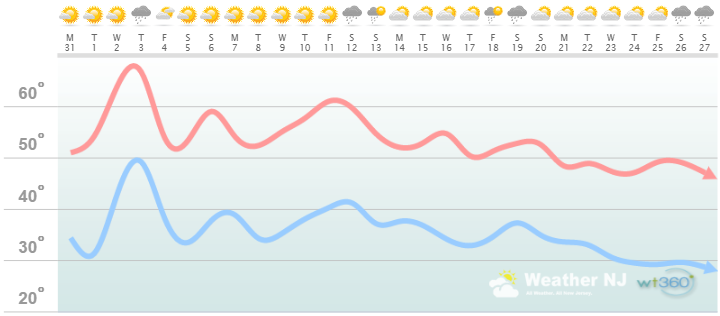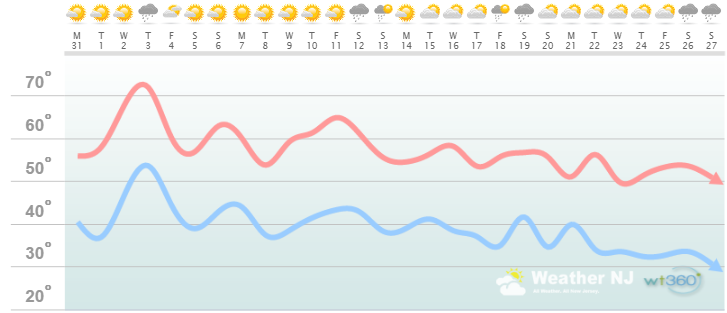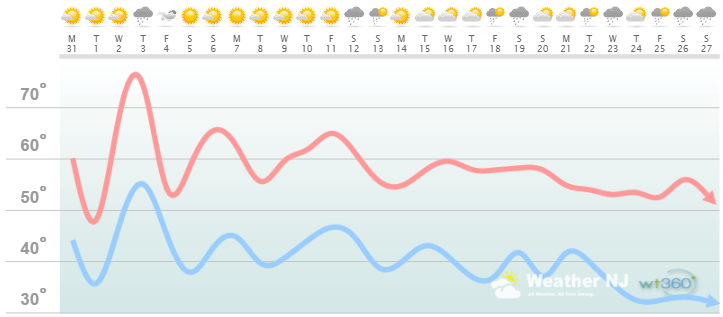What to Expect through November 2016

It’s time to harness the WeatherTrends360 proprietary weather algorithms to see how November of 2016 should play out. But first lets break New Jersey into proper climatological regions. We have the higher elevations of NNJ/NWNJ, the interior coastal plain (SWNJ through CNJ and into NENJ), and the coastal regions (most of SENJ). I’ll be representing each climatological region with a 28-day graph from weathertrends360 data followed by a brief discussion. Please keep in mind that these algorithms are documented with an 84% verification rate and are based on oceanic water cycles, time table series and very complex mathematics. The best takeaway from this are general trends (cool vs warm, rainy vs dry, etc). That’s what WeatherTrends360 does best with their proprietary mathematical analysis derived from over 150 years of reactive pattern data.
Higher Elevations of NNJ/NWNJ
(Sussex, Warren, Hunterdon, Morris, N. Somerset, and N. Passaic) – Known for little to no Atlantic Ocean influence, colder-snowier winters, and drier conditions in general when compared to the coast. This region is known to get hot when high pressure sits overhead during the summer and bitterly cold during Arctic outbreaks in the winter. Elevation is a major influence that separates this micro-climate from the rest of New Jersey. This region extends into NE PA (Poconos) and parts of NY State (Catskills).

Higher Elevation Discussion: The first half of November should continue the volatile pattern shifting between warm and chilly days. This region is quickly running out of days where high temperatures will break 60 however. The noticeable shift towards a colder pattern should occur around the ~weekend of November 11-12. After that, it’s all downhill for temperatures with highs failing to escape the 40s and lows well into the 20s consistently as November wraps up. The second half of November should feature more precipitation than the first half. This elevated region’s climate is favored over other parts of New Jersey for snowfall vs rain. We’ll have to watch some of the precipitation in the second half of the month for any wintry conditions. Otherwise, November starts drier with mild temperature swings and ends colder and wetter for this region.
Interior Coastal Plain from SWNJ-CNJ-NENJ
(Salem, Gloucester, Camden, W. Burlington, Mercer, W. Monmouth, Middlesex, S. Somerset, Union, Essex, Hudson, Bergen, and S. Passaic) – Known for naturally higher temperatures due to lower elevations away from the oceanic influence. This region is also known as “heat island” due to transportation (I-95 corridor), smog, abundant asphalt, concrete, and other man-made substances that naturally absorb and retain heat moreso than natural protected land. This is why excessive heat warnings and air quality alerts are more common in this region. SWNJ always tends to run a few degrees warmer than NENJ but this region is very similar otherwise in micro-climate due to the parallel nature of the Appalachian Mountain elevations to the NW. The same micro-climate can be extended into SE PA and NE MD which tends to run just a little stormier than NJ. This however is what makes up the interior coastal plain.

Interior Coastal Plain Discussion: The first half of November should continue the volatile pattern shifting between warm and chilly days. This region is quickly running out of days where high temperatures will break 70 however. The noticeable shift towards a colder pattern should occur around the ~weekend of November 11-12. After that, it’s all downhill for temperatures with highs failing to escape the 50s and lows well into the 30s consistently as November wraps up. The second half of November should feature more precipitation than the first half. This part of New Jersey is known for the precipitation mixing battleground with cold air typically to the N/NW and warmer air to the S/SE. We’ll have to watch some of the precipitation in the second half of the month for any wintry mixing or trouble. Otherwise, November starts drier with mild temperature swings and ends colder and wetter for this region.
Coastal Regions of SENJ
(Cumberland, Cape May, Atlantic, E. Burlington, Ocean, and E. Monmouth) – Known for tremendous influence from the Atlantic Ocean. Oceanic influence keeps this zone cooler in the summer and warmer in the winter than the interior coastal plain and especially the higher elevations of NWNJ. In the summer, sea breeze fronts back into the coast and can ignite thunderstorms if enough instability is present. The cooler marine air slides under the hot air to the W and provides additional atmospheric lifting. This is both why it’s 5-15 degrees cooler at the shore than the Philly-Trenton area and why near-stationary thunderstorms can form along the coast capable of producing localized flash flooding. In the winter, the ocean is warmer than interior regions which plays a huge role in rain vs. snow—highly dependent on wind direction. When the winds chance from NE to N/NE, that’s usually when temps crash and change rain over to snow. Regardless, this micro-climate is well known, well documented and well expressed. This region extends into most of Delaware as well.

Coastal Region Discussion: The first half of November should continue the volatile pattern shifting between warm and chilly days. This region is quickly running out of days where high temperatures will break 70 however. The noticeable shift towards a colder pattern should occur around the ~weekend of November 11-12. After that, it’s all downhill for temperatures with highs failing to escape the 50s and lows well into the 30s consistently as November wraps up. The second half of November should feature more precipitation than the first half. This part of New Jersey is typically still too warm for wintry precipitation but it HAS happened before. Ocean surface temperatures just offshore are still in the 50s which would force rain over snow for this region, especially with any kind of onshore flow associated with a passing disturbance. This region is usually snowless until December but again, it HAS happened in the past (see Halloween storm of 2011 and nor’easter one week after Sandy in November of 2012). Otherwise, November starts drier with mild temperature swings and ends colder and wetter for this region.
Hurricane season ends on November 30. There is currently no tropical activity nor expected tropical development according to the National Hurricane Center. With that said, we’re now in nor’easter season and I’ll address any that occur in routine fashion with plenty of heads-up notice.
In English: November should start with temperature swings and end colder for everyone. There exists lots of long-range model guidance support for the second weekend of November starting the colder trend. By the end of November, we should be below average for both daytime highs and overnight lows. Precipitation as a whole should be more prominant for the second half of November than the first half. As far as wintry precipitation goes, it’s much more plausible for the higher elevations of NNJ than the rest of the state. Coastal regions are likely still in the rain zone through November with everyone between subject to wintry mixing if the stars were to align properly. Again, most of NJ really needs to get into December for the usual snow that we know.
Weathertrends360 is a complete, global, web solution to help retailers and suppliers capitalize on the weather and its influence on sales and marketing plans up to a year ahead. Learn how to become PROACTIVE vs REACTIVE with the weather in every phase of your business – how much inventory to buy/produce, where to allocate more/less, when to run weather-optimized advertising/marketing campaigns – weathertrends360 can help you determine all of this in minutes! 84% independently audited accuracy for both short-term and year-ahead forecasts for temperature and precipitation.
A forecast Weather Trends issued one year ago is more accurate than every other weather company’s 5 to 14-day forecasts. The University of Miami and West Point PhD Climatologist’s prove WTI’s year-ahead forecasts are several times more accurate than NOAA.
Have a great November and please be safe! JC
Jonathan Carr (JC) is the founder and sole operator of Weather NJ, New Jersey’s largest independent weather reporting agency. Since 2010, Jonathan has provided weather safety discussion and forecasting services for New Jersey and surrounding areas through the web and social media. Originally branded as Severe NJ Weather (before 2014), Weather NJ is proud to bring you accurate and responsible forecast discussion ahead of high-stakes weather scenarios that impact this great garden state of ours. All Weather. All New Jersey.™ Be safe! JC









